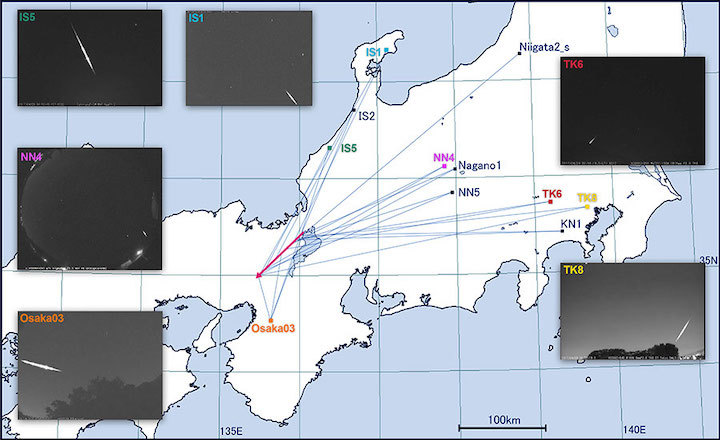17.01.2020

Images capturing the 2017 fireball from different angles and a map showing where the cameras were located. (Credit: NAOJ/Kasuga et al.)
At around 1 a.m. local standard time on April 29, 2017, a fireball flew over Kyoto, Japan. Compared to other fireballs spotted from Earth, it was relatively bright and slow. Now, scientists have determined not only what the fireball was, but also where it came from.
“We uncovered the fireball’s true identity,” says Toshihiro Kasuga, paper author and visiting scientist at the National Astronomical Observatory of Japan and Kyoto Sangyo University. “It has a similar orbit to that of the near-Earth asteroid 2003 YT1, which is likely its parent body.”
2003 YT1, a binary asteroid first detected in 2003, appears to have been active in the past, meaning it fissured and released dust particles, such as the one responsible for the 2017 fireball. It does not currently show any activity, though, according to Kasuga. However, the researchers found that the orbit, estimated radiant point, velocity and appearance date of the 2017 fireball are all consistent with dust particles that originated from 2003 YT1.
“The potential break-up of the rock could be dangerous to life on Earth,” Kasuga says. “The parent body 2003 YT1could break up, and those resulting asteroids could hit the Earth in the next 10 million years or so, especially because 2003 YT1 has a dust production mechanism.”
The researchers found that this dust production mechanism, or the asteroid’s likelihood of releasing dust and rock particles, stems from its rotational instability in a process called the YORP effect. When the asteroid is warmed by the Sun, the energy results in a small thrust, which can produce a corresponding recoil, depending on the gravitational pull and other physical variables. The recoil can twist the asteroid, introducing a rotational change. The change can be at physical odds with the gravity and/or other forces, and force the asteroid to physically break — even just a little, a process which produces dust.
“The released particles can enter Earth’s atmosphere and appear as fireballs, which is exactly what happened in 2017,” says Kasuga.
According to Kasuga, that particular fireball was not a threat to Earth, as it was estimated to only be a few centimeters in size. Something so small would burn up before it reached the surface.
“The 2017 fireball and its parent asteroid gave us a behind-the-scenes look at meteors,” says Kasuga. “Next, we plan to further research predictions for potentially hazardous objects approaching the Earth. Meteor science can be a powerful asset for taking advanced steps towards planetary defense.”
Other contributors include Mikiya Sato, Masayoshi Ueda, and Yasunori Fujiwara, all of the Nippon Meteor Society. Chie Tsuchiya and Jun-Ichi Watanabe, both of the National Astronomical Observatory of Japan, also co-authored the paper.
These results appeared as Kasuga et al. “A Fireball and Potentially Hazardous Binary Near-Earth Asteroid (164121) 2003 YT1” in The Astronomical Journal on January 13, 2020.
Quelle: National Astronomical Observatory of Japan.
